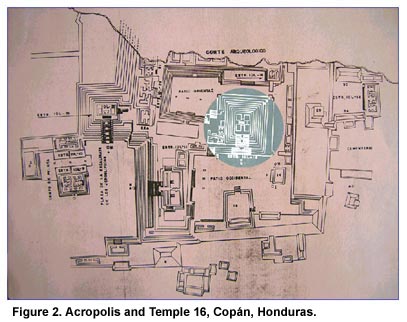
| FAMSI © 2004: Jorge Ramos |
||
|
Research on Temple 16: An Ongoing Imagery Reconstruction of Temple 16, Copán, Honduras Temple 16 and Origin of the Project The Copán core is comprised by two main elements: the Great Plaza and the Acropolis. The latter is a man-made hill, the outcome of approximately 400 years of construction of 16 kings. At its heart, it is located the imposing Structure 10L-16 (Temple 16) (Figure 2). Although Structure 10L-16 had been visited by earlier explorers by the turn of the nineteenth (Maudslay 1889-1902) and beginning of the twentieth century (Stromsvick 1935-1942), systematic scientific research in Temple 16 did not start until 1988 and was continued up to 1990 (see Agurcia et al. 1988-1990). Excavations at Temple 16 were part of a broader multidisciplinary program (Copán Acropolis Archaeological Project – PAAC) that included the participation of a range of qualified scholars in the fields of archaeology, epigraphy, iconography, art history, and conservation. 1 This program, aside from other specific scientific goals, sought to trace, document, and analyze the development of the Copán Acropolis as well as to search for the origins and founding of the Copán Maya polity in relation to the historical figure of Kinich Yax K’uk’ Mo’. During the first two seasons, investigation focused on the last version of Temple 16, although its previous construction stages (i.e., Purpura, Rosalila, Oropendola, Celeste) were also explored during this time, and in additional seasons. Facing west, Structure 10L-16 consists of a pyramidal platform of ten terraces on top of which the Maya erected a rectangular temple (Agurcia et al. 1989, 1990, 1996; Stone 1990). Analysis of stratigraphy and archaeological artifacts revealed that the temple was commissioned by the 16th ruler of Copán, Yax Pasaj contemporary with Altar Q in A.D. 776 (Agurcia et al. 1996:200). Moreover, investigations uncovered and documented approximately 1,500 sculptural fragments, some of which (the most relevant) were analyzed contemporaneously and after the field seasons of PAAC (Stone 1990; Taube 1998; Taube 2000). These studies, besides providing the configuration of some sculpture mosaics, initiated the construction of a useful database for future research. Additional sculpture fragments, originally from Temple 16, still sit on sculpture piles around the site (i.e., Piles 16, 28). Analysis of Temple 16’s architectural sculpture was continued in 2001 by the author (Ramos 2001), under the direction of Ricardo Agurcia and Karl Taube. In 2003, a more ambitious program (Iconographic Reconstruction of Temple 16 Project – PRIT-16) was designed by the author to pursue the reconstruction of the sculptural program on the façade of the temple. This program was conducted under the Honduran Institute of Anthropology and History’s (IHAH) permission and with financial support from the Foundation for the Advancement of Mesoamerican Studies, Inc., (FAMSI). During the five months of work (July 15–December 15) in the Regional Center for Archaeological Research (CRIA), I was also kindly assisted by Uziel Gomez and Juan Rodriguez, as well as by Carolina Sandoval. The primary goal of the project was the decoding of the visual message depicted on the building. There were other secondary objectives such as the elaboration of a digital database and analysis of sculpture pieces along with the possible rearticulation of sculpture mosaics; drawings as well as photographs of the motifs were also planned.
|
||
|
Text links to all pages at this site are available at the FAMSI INDEX |
||
